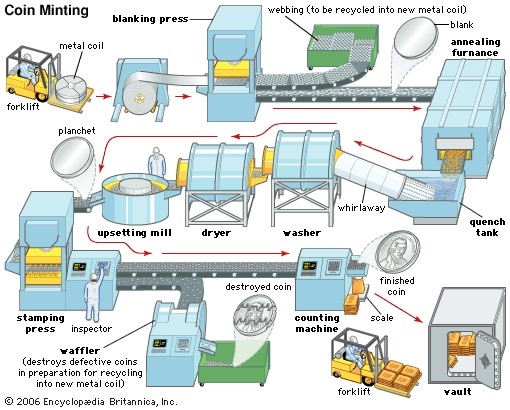Do you know , What Our Indian Coins Are Made Up Of ?
METALLOGRAPHY OF COINS IN INDIA
1.
INTRODUCTION
Welcome Readers, here we are with another interesting blog
for you in Meta Monday. India has been one of the earliest issuers of coins in
the world (circa 6th Century BC). India has unique and diverse
coinage techniques be it minting techniques, motifs, sizes, shapes, the metals used.
Currently, there are Re.1, Rs. 2, Rs.5 and Rs.10 coins in use. While using them
you must have wondered about how and what coins are made of, their metallography
and design. Here are the answers to all these questions. Let’s go through them.
2.
COIN MAKING
PROCEDURE:
Pic Credit: Britannica Encyclopedia
The above image shows the general procedure of making coins
in India.
·
Re.1 Coin:
In independent India, one rupee coins was first minted in
1950 and is currently in circulation.The one rupee coin is the smallest coin
currently in use. One Indian rupee coins are minted from stainless steel since
1992. It is made out of ferritic stainless steel, containing 83 per cent iron
and 17 per cent chromium. Round in shape, the one rupee coins weighs 3.76 grams
(58.0 grains), has a diameter of 21.93-millimetre (0.863 in) and thickness of
1.45-millimetre (0.057 in).
2011 Rupee Symbol Series
2007 Nitya Mudra Series
Ferritic Stainless Steel (Metal Changes)
·
Rs.2 Coin:
The Indian 2-rupee coin is a denomination of the Indian
rupee. The 2 rupee coin was introduced in India in 1982. Until then, the Rs.2
was in circulation in banknotes. The old Rs.2 coin was minted with cupro-nickel
metal. The new Rs.2 coin was minted in ferritic stainless steel.
2011 Rupee Symbol Series
2007 Nritya Mudra Series
New Denominations of Rs. 2
·
Rs. 5 Coin:
The Indian 5 rupee coin is a denomination of the Indian
rupee. The ₹5 coin was the highest denominated coin until the minting of the
₹10 in 2005. According to a research paper, EDXRF technique has been used to
study material compositions of five rupees coins. Since Year 1990-2000,
Cupro-Nickel alloy, from 2000-2010, Nickel Brass alloy and from 2010 to till
date, Ferritic Stainless Steel (FSS) has been preferred for coin Manufacturing
process. The possible reason for this material amendment could be the Clearly
attributed to high cost and low availability of nickel (Ni) as compare to low Cost
and easy accessibility of Iron (Fe) in modern coins. Besides these elements,
traces of Mn, Cr has been also observed which act as the strengthening
elements.
2007-09 Connectivity and Information Technology Series
New Denominations of Rs. 5
·
Rs. 10 Coin:
The Indian 10-rupee coin (₹10) is a denomination of the
Indian rupee. The ₹10 coin is the second highest-denomination coin minted in
India since its introduction in 2005. The present ₹10 coin in circulation is
from the 2019 design. However, the previous ₹10 coins minted before 2019 are
also legal tender in India. All ₹10 coins containing with and without the rupee
currency sign are legal tender, as stated by the Reserve Bank of India. Along
with the standard designs, there are 21 different designs for this denomination
and are minted as circulating commemorative coins, this is used alongside the
10 rupee banknote.
2011 Rupee Symbol Series
2005-06 Unity in diversity Series
·
Rs.20 Coin:
The government has announced new Rs 20 coin which will be
shaped like a 12-edged polygon (dodecagon). The outside diameter of new Rs 20
coin will be 27mm (millimeters) and it will weigh 8.54 grams. The composition
of the new coin will be 65 per cent copper, 15 per cent zinc and 20 per cent
nickel for the outer ring, while the inner ring (centre piece) will be 75 per
cent copper, 20 per cent zinc and five per cent nickel.
3.
A BRIEF HISTORY:
·
Metallography of
metals used in Indian coins:
|
Gold (1835-1918) |
91.7% or 22 carat. |
|
Standard silver (1835-1919) |
91.7% silver+ 8.3% copper |
|
Silver
alloy (1939-1945) |
50%silver + 40%copper+ 5%nickel +5%zinc |
|
Bronze (1906-1964) |
95-97% Copper+ 4-21.7% |
|
Silver alloy (1969-1971) |
80%silver + 15% copper+ 5% nickel |
|
Silver alloy (1972-2002) |
50%silver + 40%copper+ 5%nickel +5%zinc |
|
Copper (1835-1906) |
pure copper |
|
Copper nickel (1906-2002) |
75% copper+ 25%nickel |
|
Nickel brass (1964-71, 2009-11) |
79% copper+ 20% zinc +1% nickel |
|
Nickel (1946-74) |
Pure nickel |
|
Aluminum (1965-93) |
96%Aluminium+ 4% Magnesium |
|
Aluminum Bronze (1969-71) |
92%copper + 2% nickel + 6% Aluminum |
|
Stainless Steel (1988-2002) |
Ferritic Stainless Steel ( chromium 17%, iron 83%) |
4.
REFERENCES:
Ø
https://m.rbi.org.in/Scripts/mc_coinage.aspx
Ø
https://www.quora.com/How-are-coins-made-in-India
Ø
https://m.rbi.org.in//Scripts/restrospectcoins.aspx
Ø
https://www.scribd.com/document/260692108/metal-composition-of-1-rs-coin
Ø
http://www.ripublication.com/iraer.htm
NOTE :-
This blog is meant for Educational Purpose only .We do not own any Copyrights related to images and information , all the rights goes to their respective owners . The soul purpose of this blog is to Educate, Inspire, Empower and to create awareness in the viewers. The usage is non-commercial(Not For Profit) and we do not make any money from it.
















Comments
Post a Comment